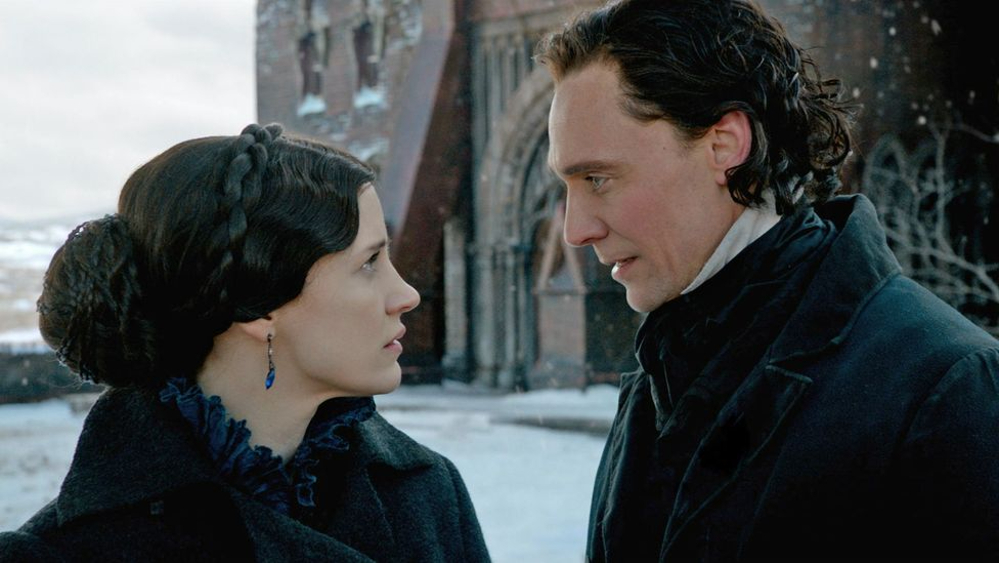
Dir: Guillermo Del Toro, US, 2015, 119 mins
Cast: Mia Wasikowska, Jessica Chastain, Tom Hiddleston, Charlie Hunnam, Jim Beaver, Burn Gorman
Review by Dan Woburn
Crimson Peak is vintage Del Toro, as he pushes his gothic proclivities into overdrive on the amazing set that is Allerdale Hall. Set in the late 19th Century, the story follows aspiring writer Edith Cushing (Wasikowska) as she is swept off her feet by English baronet Thomas Sharpe (Hiddleston, dashing and brooding as ever) and whisked from Buffalo, NY to cold, draughty Cumberland to inhabit his cold, draughty manor with his cold, draughty sister Lucille (MVP Jessica Chastain, bringing her A game).
The twist in the tale is that Edith is prone to seeing ghosts, and Allerdale Hall is chock full of them.
Although the film has an absolutely fantastic set-up, where we start the story in Buffalo, the first act is similarly plagued by a really bad case of awful over-dubbing – to the point where it’s excruciatingly noticeable at several points. It’s a problem that is thankfully relegated to the first act, and is a (slightly) forgivable trespass as Del Toro’s set-up is so finely tuned otherwise. The period setting, the costumes, the dialogue, the slow burn of the plot – the maestro settles you in nicely for the decidedly plodding ride ahead.
The central mystery of the film, which keeps you guessing until ultimately it unveils itself as an “is-that-it?” kind of revelation, misleads the audience into thinking that it’s the point of the whole film. It’s not. The characters are the real draw here – something Del Toro is expert at, yet seemingly forgot last go round in Pacific Rim – and the dawning realisation that we’re actually watching a pretty damn good character piece comes late in the game. The real interesting characters of the film are the Sharpe siblings, as their motives remain unclear for a while, but the reasons behind said motives become so chillingly understandable from a psychological standpoint that these two can’t help but present themselves as truly tragic figures in the story.
The letdown is probably Edith Cushing, whose character almost disappears off the page for the first half of the film apart from the large personality traits of family tragedy and the desire to be an author. It doesn’t help that she’s played by the decidedly vanilla Mia Wasikowska. Del Toro manages to rectify this situation by turning Edith/Mia into a great scream queen towards the end – a feisty female ahead of her time who can barely stand for piddling BS and fights for her own survival in the most admirable of ways.
The plot-progressing mystery thrums along, offering up CGI ghosties that are far from scary. Del Toro, the master of modern horror/fairy tale mash-ups, seems to sense this, and instead opts for the bottom-of-the-barrel option of jump scares backed up by orchestral bumps in the score. The ghosts themselves have the effect of obviously dripping in clay from the hill where Allerdale Hall resides – this is where it gets its moniker, Crimson Peak – an intriguing idea on paper, perhaps, but the CGI reality is that these spectres look like the walking, talking equivalent of 18th Century sealing wax. A mite of the fear is thusly taken out of proceedings.
Eventual plot twists are easy to see coming but backed up heavily by the emotional payoff inherent in the way the characters are written. Del Toro has managed to craft a truly classic horror story – the kind that feels like it was filmed in the 40s or 50s, if they had monumental budgets, colour film and CGI. His filming technique feels very 60s-inspired, although some of the scene transitions border on Looney Toons. You’ll know them when you see them. There is some much-missed, old school Del Toro gore thrown in for good measure – anyone who enjoyed the ‘gun-meets-nose’ scene in Pan’s Labyrinth will be more than pleased during a few moments of Crimson Peak.
The real draw of the picture, in the end, will be the one-two punch of Jessica Chastain and Tom Hiddleston, who sell every single facet of their characters. The film hums with intensity whenever they grace the screen, and if horror weren’t completely ignored by the Academy, one or both of them could be up for consideration. One of the setbacks is Charlie Hunnam and his permanently imperfect yank accent, but he cuts such a heroic figure that you can forgive him that. It’s also always good to see Jim Beaver get great roles to show off his gruff American demeanour, in this case as Edith’s father.
This film so obviously comes across as the passion project it was for Guillermo; an experiment on his part that half succeeds and half fails in the telling. What can’t be denied is the conviction with which he delivers the entire story; everything from the production design to the character development shows nothing but time, care and attention having been shoved into it. There’s an intriguing mystery, a few genuine scares, several laugh-out-loud moments (seemingly unintentional – the moment we witness the foreboding, grim portrait of Mama Sharpe had the audience we were with in stitches) and more than anything, a beautiful, tragic ending.
Just because all of the pieces don’t necessarily come together, it doesn’t mean we can’t see Del Toro’s trees for the forest it ultimately produces. Crimson Peak is a worthwhile trip to the cinema.


